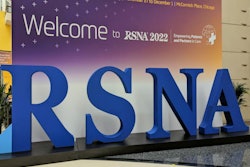
Now in its second year of operation, the RSNA-American College of Radiology (ACR) 3D Printing Registry is accumulating data that will enable quality improvement and set the stage for reimbursement for 3D printing in radiology, according to research presented at RSNA 2022.
A team of researchers led by Dr. Kenneth Wang of the Baltimore VA Medical Center analyzed over 2,000 3D-printed models and guides that have been submitted to date to the registry. In addition to assessing usage patterns, they've found that 3D printing led to an estimated time savings of nearly 40 minutes in the operating room or interventional suite.
"Registry data now starts to let us kind of quantify how 3D printing is being practiced in hospitals and clinics," he said. "What we've seen is that these cases are being performed for a range of clinical indications using a number of different printing technologies. We can now start to measure the amount of time that's required to perform 3D printing for these cases and begin to demonstrate some of the savings and benefits associated with these cases."
The registry for 3D printing performed in hospitals and clinics was launched for two main reasons: quality improvement and laying the groundwork for reimbursement, according to Wang.
"By collecting information from around the country about how 3D printing is practiced, registry data will allow people to compare their own practice of 3D printing with that of a broader community and to engage in quality improvement from that perspective," he said.
Wang noted that the U.S. Centers for Medicare and Medicaid Services (CMS) doesn't currently consider 3D printing to be a reimbursable activity.
"By collecting data about what people are doing, why they're doing it, and how they're doing it, you can start to build an argument for reimbursement for this work," he said.
The RSNA and American College of Radiology (ACR) are collaborating on the project, which is being hosted using the ACR's National Radiology Data Registry (NRDR). Other registries hosted on NRDR include the ACR Dose Index Registry, the ACR National Mammography Database, and the Lung Cancer Screening Registry.
Popular indications
The registry has been accepting cases since March 2021. To date, 19 institutions have submitted a total of 2,136 cases, including 1,549 3D-printed models and 587 3D-printed guides. The registry collects information about the clinical indication for performing 3D printing.
Overall, the top five indications by organ system were the following:
- Neuro
- Breast
- Cardiac
- Musculoskeletal (MSK)
- Genitourinary (GU)
As for printer technology, the most common type was material jetting, followed by material extrusion and vat photopolymerization, Wang said.
For models, the most common indications by organ system were breast, cardiac, MSK, and neuro. Drilling down further into the data, the researchers found that a large majority of the models created for breast diagnosis in the registry were produced using material jetting. The most common indications by organ system for guides were GU, neuro, and MSK.
Time spent, saved
As the registry collects data on the staff time required to perform 3D printing, the researchers also assessed the effort required of clinicians (physicians and other qualified healthcare providers) and nonclinicians (scientists, engineers, and technologists) to produce the 3D models.
On average, clinician staff spent an average of 89.9 minutes per case, while the nonclinician staff spent a total of 304 minutes per case. Although only a small fraction of the submissions included an estimated time savings in the operating room or interventional cardiology suite, the estimated time savings in those cases was 38 minutes, Wang said.
Wang pointed out, though, that time savings is only a very small piece of the overall purpose of 3D printing. There are many other important factors.
"So, for example, 3D printing can improve the precision of an intervention," he said. "How do you quantify that? We also have data that shows that the confidence of surgeons heading into a procedure using 3D printing increases."
Also, time savings in the OR represents time saved in a very expensive resource, he said. It also implies shorter anesthesia time.



















